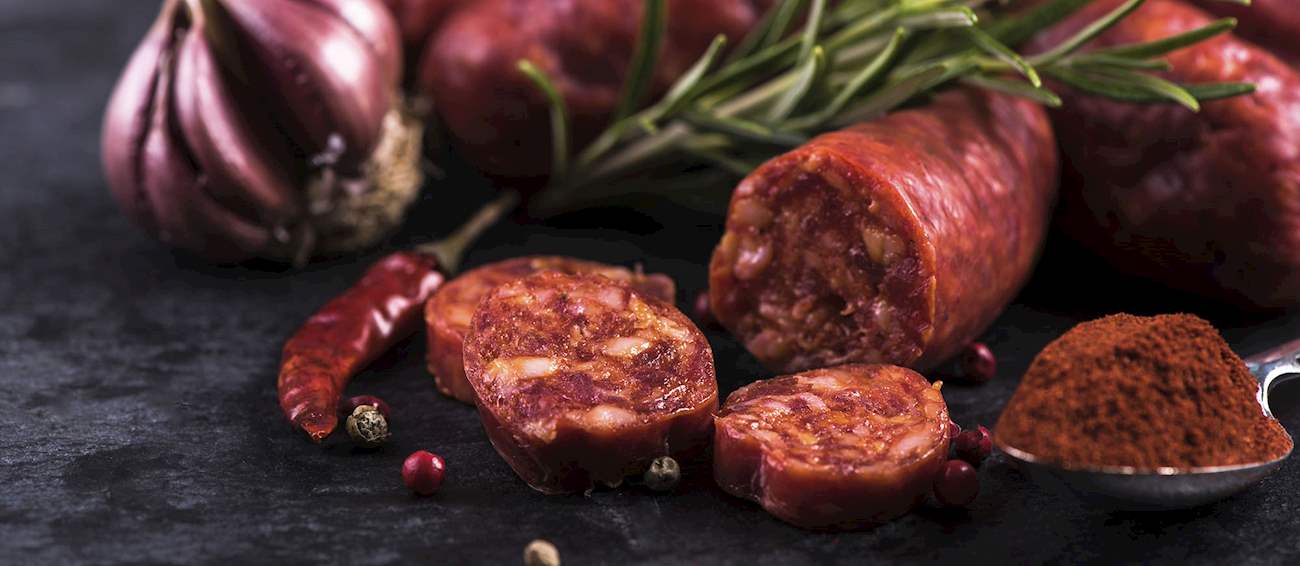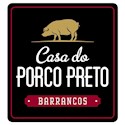Best Portuguese Sausage/Salami Types
Beja paio sausage is a smoked meat product made from pork of the Alentejo breed of pigs. Roughly 70-90% of the sausage consists of lean meat, while the remaining 10-30% is fat. The pork meat and fat are diced and mixed with water, garlic, paprika, and salt before being stuffed into sausage casings.
The smoking process lasts for several days, and is carried out at a low temperature using local oak wood. Paio has a firm consistency and a pleasant, delicate flavor that is savory and slightly spicy. Served with bread, this sausage is a traditional meal that is brought to the fields by local farmers during the harvest.
This smoked sausage is similar to chorizo, but longer. It is made with the meat and fat from the Alentejo breed of pigs, along with flavorings and seasonings such as paprika, pepper, salt, garlic, and wine. The mixture is marinated briefly before being stuffed into sausage casings which are subsequently smoked and dried.
The texture is smooth and marbled, while the flavor is slightly salty with a typical smoky aroma. This sausage is often sliced and pan-fried for a typical breakfast dish. Extra thin slices also make for a great pizza topping or a filling for francesinha, a traditional Portuguese sandwich.
Chouriço is a traditional sausage that's usually made with pork, fat, and spices such as paprika, garlic, red wine, salt, and black pepper. The meat mixture is packed into natural casings, and the sausage is then slowly dried over smoke.
Chouriço has considerably less paprika and more garlic and black pepper than its Spanish counterpart, chorizo. There are many varieties of chouriço in Portugal, and it's usually sliced halfway through and cooked over flames in an earthenware dish – a method that's called chouriço à bombeiro.
The sausages can also be flambéed with aguardiente.
VARIATIONS OF Chouriço
THE BEST Chouriço Sausages
This chorizo sausage is made with pork taken from Alentejo breed pigs raised in the municipalities of Borba, Estremoz, Vila Viçosa, and Alandroal in Portugal's Portalegre district. The pigs feed mainly on acorns, which provide a unique, unmistakable flavor to the meat used for these sausages.
The meat is cut into small pieces and mixed with garlic, paprika, salt, and water. The mixture is then stuffed into sausage casings and smoked until it develops a dark-red to black color and wrinkled texture. The sausages have a pleasant, smoky, garlicky aroma and a well-nuanced balance of sweet and savory flavors.
This sausage is made with fatty cuts of pork taken from the Alentejo breed of pigs with the addition of wheat flour, garlic, paprika, salt, and water. The animals are fattened and fed mostly on acorns, which imparts a distinctive flavor to their meat.
The meat is cut into small pieces and mixed with seasonings, after which it is stuffed into sausage casings and smoked slowly over an oak fire. The final product is a horseshoe-shaped sausage that is yellow to orange in color, with a semi-soft, pasty texture.
Vinhais salpicão sausage is a traditional smoked sausage made from pork of the Bísaro breed of pigs from Vinhais in the municipality of Bragança. Bísaro pig farming is widespread throughout this area, and it is an important source of income for the local rural population.
The pigs feed on chestnuts and acorns, which gives the meat and its products a unique flavor of the Portuguese north.
The sausage is made by combining pork loin with local wine, salt, garlic, bay leaves, and paprika and leaving the combination to marinate.
This horseshoe-shaped sausage is made with meat and lard coming from Bísaro breed of pigs. Ground pork is mixed with wine, garlic, salt, powdered chili pepper, and paprika, and it is then stuffed into a thin sausage casing before being smoked for 10 to 15 days.
The finished sausage ranges from yellow to brown in color and has visible pieces of fat throughout it. Barroso-Montalegre chorizo is made in the Montalegre region of Portugal, where the cold, dry climate and unique smoking conditions are perfect for the production of sausages.
This smoked chorizo sausage is made with meat taken from the Alentejana breed of pigs. The meat is cut into pieces and mixed with water and various seasonings before being manually stuffed into sausage casings and left to smoke slowly over an oak fire.
The finished sausages have a pleasant, mild, and delicately spicy flavor and a smoky aroma. They can be preserved in oil and are often used as a key ingredient in a variety of traditional Portuguese dishes. The unique flavor of this chorizo sausage stems from the fact that the pigs feed almost entirely on acorns which impart a distinctive flavor to their meat.
This smoked chorizo sausage is made from the meat of the Alentejo pig, which is raised throughout the district of Portalegre in Portugal. All of the meat used in this type of sausage must be taken from Alentejo pigs in order to be sold as chouriço mouro de Portalegre.
The meat, fat, and blood are mixed with sweet paprika or red bell peppers, salt, garlic, and local wine, with the optional addition of caraway seeds. The mixture is then stuffed into sausage casings and smoked over a fire of locally-grown oak wood.
The final product is a red-to-dark-brown sausage with a semi-hard texture and a unique, meaty, smoky flavor.
According to EU directives, Portalegre blood sausage can only be produced from the fat and blood of Alentejo pigs in the Portuguese district of Portalegre. The first written records of this smoked black pudding date to the mid-18th century, but one can assume that the farmers of the region have been making it since much before.
This product was yet another ingenious way of making use of all possible parts of a slaughtered animal, even the fat and blood, and the smoking process additionally extended its shelf life. To make Portalegre black pudding, soft fatty tissue is crushed, blood is added, and the two ingredients are mixed into a paste.
Best Portuguese Sausage/Salami Producers
Casa do Porco Preto is a renowned Portuguese producer specializing in Presunto de Barrancos DOP, a dry-cured ham made from free-range Alentejano black pigs. Located in the Alentejo region, the company emphasizes sustainable farming practices, allowing pigs to roam freely and feed on acorns, which enhances the flavor of the meat.
Their presunto is aged for extended periods, often over 24 to 36 months, resulting in an intense, nutty, and melt-in-the-mouth flavor. Casa do Porco Preto has received numerous accolades for its dedication to artisanal craftsmanship and adherence to traditional curing methods.
BEST Casa do Porco Preto Meat Products
Mestre Henriques, established in 1978, is a family-owned Portuguese company specializing in traditional charcuterie and sausage production. Their products are crafted using fresh pork, carefully selected seasonings, natural casings, and are smoked over holm oak wood, adhering to authentic Portuguese methods.
Located in Rio Maior, the company offers a diverse range of items, including traditional chouriço, black pudding, and paiola. Mestre Henriques is committed to upholding high-quality standards, catering to discerning palates both domestically and internationally.
BEST Mestre Henriques Meat Products
TasteAtlas food rankings are based on the ratings of the TasteAtlas audience, with a series of mechanisms that recognize real users and that ignore bot, nationalist or local patriotic ratings, and give additional value to the ratings of users that the system recognizes as knowledgeable. TasteAtlas Rankings should not be seen as the final global conclusion about food. Their purpose is to promote excellent local foods, instill pride in traditional dishes, and arouse curiosity about dishes you haven’t tried.






















